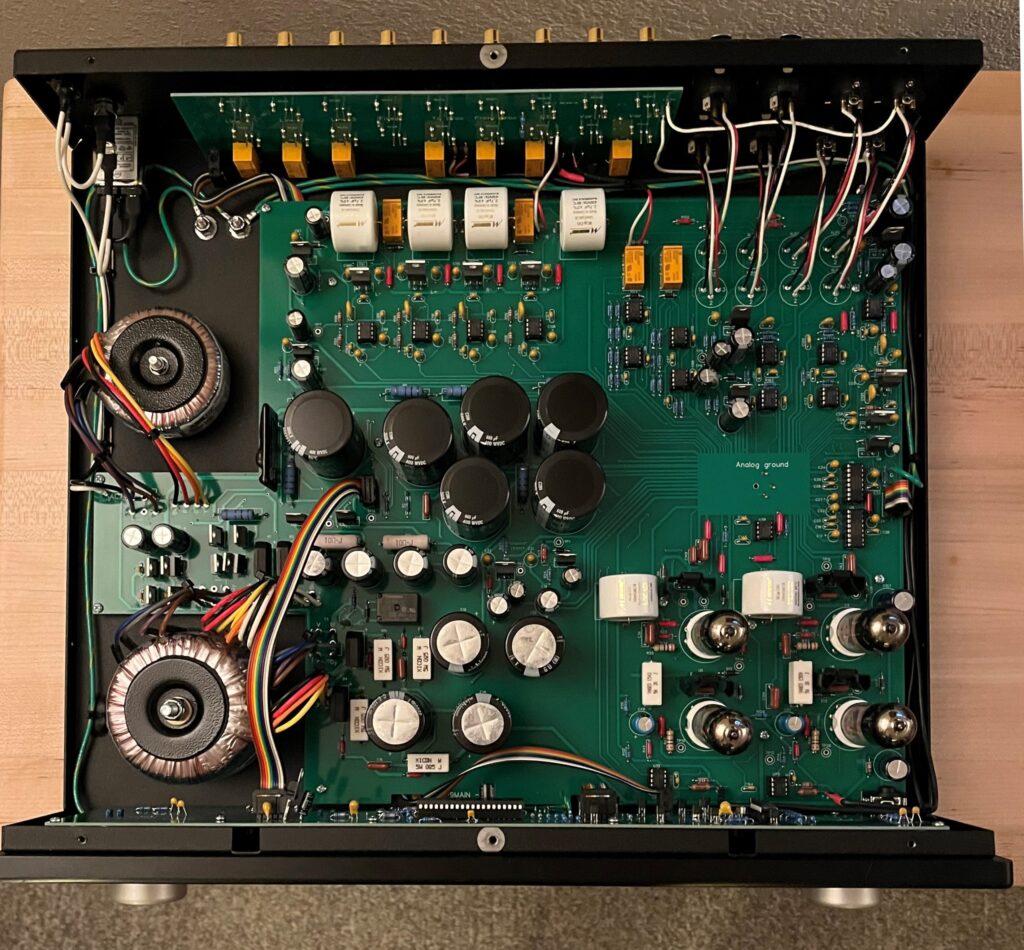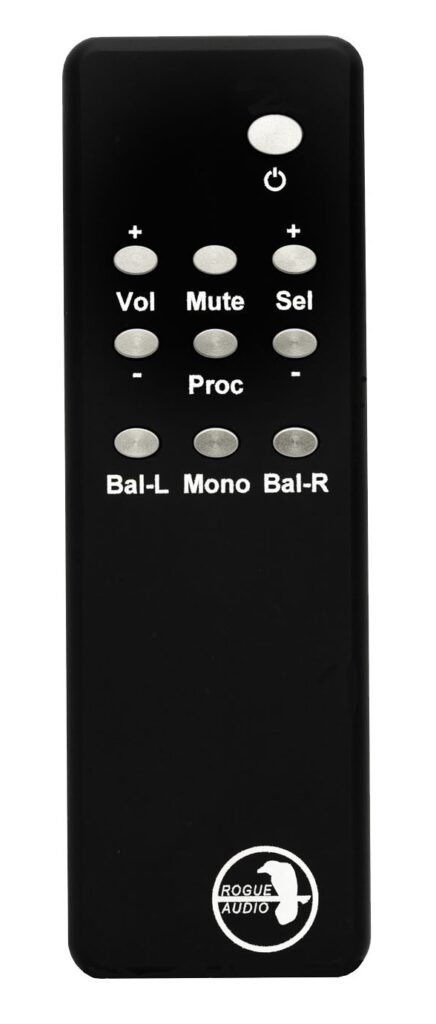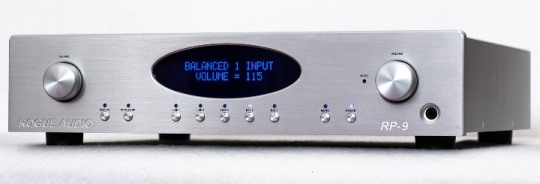The Rogue Audio RP-9 line stage preamplifier has been on my “must audition” list since it first appeared in 2018. Having owned and reviewed other high-performance components from Rogue Audio, I asked Rogue’s Mark O’Brien if he would be interested in a review.
The RP-9 is at the top of Rogue’s preamplifier product line, which currently includes the RP-1, RP-5 and RP-7. The Rogue RP-9, $7,495, employs four 6H30 vacuum tubes. The RP-9 continues to use Rogue’s award-winning RP-X hardware and software platforms, although both have been upgraded to a new, higher level. The goals for this preamp were near perfect signal integrity along with an ultra-wide bandwidth, low distortion and extremely low noise floor. There is a home theater bypass, processor loop, mono button, and an easy-to-read OLED display. The aluminum 10 button remote is substantial and easy to learn and use. A headphone amplifier is also included. Rear connections include two XLR and three RCA inputs per channel, two XLR and two RCA variable outputs, and a fixed output on RCAs. A 12V trigger facility is not present.
The chassis is heavy and feels very solid, weighing 30 pounds. New owners enjoy a 3-year limited warranty, although it is hard to image that a warranty would be consulted. All Rogue Audio gear, in this listener’s experience, have operated perfectly and without any failures or unwelcome noises. The RP-9 carries on this tradition of design excellence. Now let’s see how it sounds.
Other components on hand during the audition and review include Acoustic Signature Montana Neo turntable with Acoustic Signature TA-7000 Neo and Origin Live Agile tonearms; ZYX UNIverse Optimum, Miyajima Destiny, and Tzar DST moving coil phono cartridges; BMC MCCI ULN, Simaudio Moon 810LP, and Aurorasound Supreme phono preamplifiers; Soulution 325 with phono, Pass XP-22, and Benchmark HPA4 preamplifiers; digital is handled by a custom Windows 10 computer running JRiver Media Center with a USB-connected Audio-gd RM-7 MK2 and Marantz SA-10 DACs, and RME ADI-Pro 2 Black Edition AD/DAC with external power supply; Valvet E2 SE and Benchmark AHB2 power amplifiers; Alta Audio Celesta FRM-2M and Magico S1 MkII speakers. The Magicos are lightly augmented in the low bass with a pair of JL Audio e110 subwoofers. The audio cabling is Audioquest WEL Signature and Mogami interconnects and speaker cables. USB cables are StraightWire USB-F. Power protection and purification are provided by a PS Audio Dectet for the preamplifiers and source components, and a PS Audio Quintet for the power amplifiers. The Quintet includes a standard 1/8″ trigger connection enabling remote turn-on and -off of power amplifiers that lack a 12V remote trigger. Power cords include my DIY power cord, and Straight Wire Pro Thunder. An Acoustic Signature Grip, Origin Live Gravity One, and the new Stillpoints Ultra-LPI mk2 record clamps were employed during the review period.

The ability of the Rogue preamp to keep up with the demands of the music signal is unquestionable. The RP-9 is a great example of preamplifier excellence by keeping the music sorted and not a congealed, indistinct sound field. If you want to hear if your system can keep up, listen to Brad Paisley’s “Make a Mistake With Me” and “Mr. Policeman”. The Rogue preamp has the speed and composure with these and all other recordings, from solo acoustic to full orchestra to the electronic bombasity of the band Yello.
There is a small difference between the sound of the preamplifier and the sound of a bypass, when the input XLRs are connected directly to the output XLRs and volume is controlled in JRiver Media Center. The basic frequency response is unchanged, presenting excellent bass, saturated midrange, and extended treble. Within a few seconds of clicking Play in JRiver, and here using a video analogy, it sounds as if the “color” control is turned up a notch. Sounds have greater body and depth. The midrange is not highlighted or more forward, but it is more densely populated with a continuous, and large, sound field.

Cymbals have the true-to-life sound of real metal ringing. Bass is detailed and powerful. It is easy to focus our attention on a specific performer, which is a benefit of high resolution. There seems to be more depth or relief from other sounds or performers, with individuals taking on more body and uniqueness. The RP-9 delivers rich tonal depth that gives all performers a very natural sound quality. Male or female vocalists sound superb with the RP-9. Harmonics are well served by the very linear and beautifully high-resolution presentation.
Listen to Matt Bianco’s “Half a Minute”, and you’ll hear Sade’s outstanding tone and presence. Her distinct voice is unmistakable, and thoroughly entertaining. The bass on his recordings is usually tipped up, and the lower registers are room-shaking while remaining detailed and “tight”. The lower octaves are outstanding. The bass is powerful and articulate, although the leading edge of explosive sounds or drum hits can occasionally seem slightly blunted.

Compared to the Benchmark HPA-4, which is the preamp closest to the ideal “straight wire with gain”, the Rogue is warmer with a greater focus on a wonderfully rich midrange and a small amount more prominent bass. Singers are special and the upper frequencies are richly detailed, although not quite as extended or clinical as the Benchmark. The Rogue preamp sounds similar to the Soulution 325, $13,000, but the RP-9 is much better focused and 3-dimensional, and simply more interesting to listen to. There is no question that the Pass XP-22 has a silicon heart, especially after listening to the Wilson sisters of Heart singing through the vacuum-tube Rogue. The RP-9 has humanity.
The very nice casework includes a vented screen above the tubes. The screen is not a hardware store add-on, but is precisely machined into the top panel. Two expensive Mundorf silver/gold/oil capacitors can be seen near the tubes. The right side of the enclosure, closest to the four 6H30 tubes, reaches uncomfortably warm temperatures during normal operation, so adequate ventilation is recommended. Using the remote control, especially to control volume from the listening seat, is a pleasure. The only ergonomic issue, a minor one that Rogue may address down the road, is the display can be turned off from a switch on the front panel. The display will stay off until that same switch is used again which means that you must, and I apologize in advance if anyone finds this offensive, stand up and walk to the preamp to see a new volume setting! As I said, minor, and more of a personal preference.

The RP-9 sounds very good right out of the box due to the “fully tested, burned in and auditioned” factory procedures. Our standard break-in interval of 100 hours was applied before the real audition commenced. A good component will deliver music in all its parts, and the Rogue RP-9 is easily competitive at this price and above. This invites the listener to enjoy a special connection with the individual performers. The first reaction upon listening was “What a treat!”. There is nothing in the RP-9’s presentation that is not musical, and properly musical at that. The most relevant question for a review to answer: “Is this component worth your time?” The answer is “Yes”!
Overall Rating: 9.5 LPs
Link to manufacturer: Rogue Audio
This review would not have been possible without the very kind support of Mark O’Brien at Rogue Audio. Thank you!

